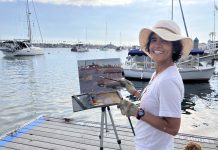
Ahoy!
Good news for boaters, especially for those at the helm of larger sailboats, as Newport Harbor may have the dredging project expanded to restore the harbor to the original navigable charted depths. We have all felt the bay’s seafloor scrape our boats from time to time, and there are many areas in the harbor where the props stir up the muck, making the water look like a chocolate milkshake.
There are some sailboats that will not enter the harbor for the fear of hitting the bottom of the bay with their keels. At low tide, many boats are touching bottom, and do not take a deep breath along the seawall in the Fun Zone. The smell will knock you off your feet, or at least make your eyes water.
However, that can all change if the City Council funds between $2.5 million and $3 million for further dredging with another $2.2 million coming from the feds. Overall the complete additional dredging will cost approximately $25 million.
The Port of Long Beach is helping save the city millions and millions of dollars by allowing dumping there of the sediment dredged from our harbor. The sediment from the Rhine Channel was classified as too contaminated to dump in the ocean at LA-3 disposal site. However, the Port of Long Beach is expanding an area of the harbor, and filling in a section of the harbor to create new land mass. So, a tug tows the dredging barge to Long Beach where the sediment is dumped, and this method costs significantly less then trucking the material to an inland landfill site for hazardous waste.
There are benefits of dredging the bay other than just providing safe navigable waters for boaters. Dredging will increase the water depths, which will allow for better flushing by the tides.
Let the dredging continue, and I tip my Captain’s hat to the city for finally addressing the water depths in the Newport Harbor.
Tip of the week is to remind boaters that it is lobster season, and I am hearing reports from skippers about the scores of floating buoys that are tethered to the lobster pots lining up seaward from both of Newport’s jetties’ tips. Boaters need to travel this area with caution and watch out for the lobster pot buoys.
You want to avoid entangling the buoys’ lines around your keel, running gear or wrapping the lines in your propellers. Your best course to clear the buoys is by maintaining a straight course between the jetty entrance and the mid-channel marker.
Let me explain the line of demarcation and the proper approach and departure from Newport Harbor. Most people are familiar with the floating bell buoy in the ocean where sea lions haul out just outside the jetties. This buoy was once labeled Buoy No. 1 and painted green (originally painted black) as prescribed by the lateral system of buoyage for all odd-numbered can buoys. A few years ago, to aid vessels with the harbor approach, the bell buoy was changed to a mid-channel buoy and, as such, painted red and white — vertically striped with a white light flashing Morse code alfa ( –).
Thus, a boater is to pass close on either side of this buoy when entering or exiting the harbor entrance.
The inland-international line of demarcation is an imaginary line drawn between both channel markers located on the tips of the West and East jetties. Green marker No. 3 is positioned on the West Jetty with a green flashing light and the East Jetty has red marker No. 4 with a red flashing light.
The proper outbound vessel course is to traverse the channel between the rock jetties with the vessel, keeping its starboard side nearest the West Jetty, and once you pass marker No. 3 to continue seaward, passing the mid-channel marker off your portside before changing course. When you are approaching the entrance from the sea, you should line up passing the mid-channel marker to your port side and marker No. 4 off your starboard side.
By following this prescribed approach, you should miss the lobster pots, but remember the pots will drift from time to time.
And don’t forget: Tune in to the No. 1 boating radio talk show in the nation, Capt. Mike Whitehead’s Boathouse Radio Show, broadcasting coast-to-coast on the CRN Digital Talk Radio syndicated network every Saturday at noon, Pacific Time and replayed on Sunday at 10 am Pacific. Join Chandler Bell, Craig Carpenter, and me as we talk about “all things boating.” You can find the station listings, cable TV channels, live streaming on the Internet, and now available are apps to listen to the show for your iPhone, Blackberry, iTouch, Android, Palm, and Windows Mobile at www.BoathouseTV.com or www.BoathouseRadio.com.
Until next week, Safe Voyages!





This is one of the most essential needs of the Harbor area. Economic, recreational and environmental issues are dramatically involved. Kudos to Leslie Daigle and her fellow Council Members together with City Manager Dave Kiff who have worked tirelessly to bring about the financial resources and disposal solutions to make it happen. Congressman Ed Royce is also to be thanked for his efforts in securing federal dollars. We owe them all a vote of thanks!
Ahoy Marian, thank you for your comment and as you probably know, I agree with you 100% to the needs and your kudos list. However, there are others behind the scenes that deserve kudos as well. Thank you for your support of the Newport Harbor and value to the harbor area.